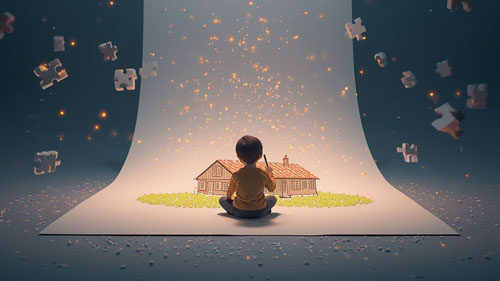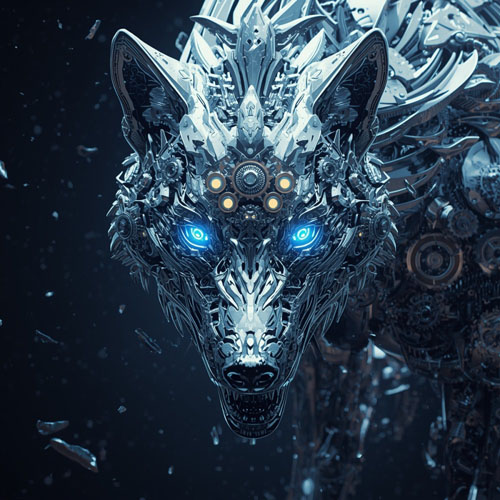
Software Engineer
Ever Wondered How AI Can Turn Imagination into Images?

Introduction
Not copied images, but completely new pictures created from just a short prompt — like “a metallic wolf.”
I’ve always loved it when complex ideas are explained in simple, intuitive ways. As a child, I often struggled to follow explanations in class. I was an “out-of-class” learner, someone who needed to build my own mental models to make sense of the world.
Today, when I try to understand how AI generates images, I’m confronted with a flood of technical terms: diffusion, latent space, noise and denoising, time steps, forward and reverse processes.
They sound like a conversation between two machine learning experts, not something a curious learner can grasp.
I wanted to take a small step toward making this complexity easier to understand.
So here’s a way to think about it — without any machine learning jargon.
Imagine a Puzzle Master
You give a master puzzler a beautiful picture. They start shaking the table, gently at first, then harder and harder, until all the pieces scatter.
That’s what happens when we add randomness: order turns into chaos.
Now, the puzzle master studies what each stage of that mess looks like. They don’t memorize the picture, they learn how pictures fall apart step by step.
Later, you hand them a box of random pieces, no original picture at all, and say: “Make me a metallic wolf.”
The master begins calmly reversing the chaos.
When you have pixels as puzzle pieces, you can create dreamlike combinations of them.

What is the Role of the Prompt?
At every move, the master thinks:
“If this is supposed to be a metallic wolf, how should I rearrange these pieces?”
Your prompt tells the master which randomness to remove from the chaotic picture.
The main difference from real-life puzzle pieces is that in this case, the puzzle pieces are pixels, tiny dots on your screen.
When you have such small pieces, you can create an unlimited number of new combinations.
Another difference is that unlike real-life puzzles, the puzzle pieces (pixels) do not move but change in color, shade, and brightness. The master learned which changes make meaningful pictures during training.
Piece by piece, the randomness starts to form a pattern. Each round removes a bit of the chaos until a completely new image emerges.
Not a copy, not a memory — but a new creation that fits the idea you described.
How Does AI Know When the Image Is Ready?
When the model learns how to turn a picture into chaos, it also learns how many steps it takes.
This means it knows that creating a coherent image from a jumble of chaotic puzzle pieces typically requires around 50 to 1,000 careful steps, a sequence that’s built into the process.
That’s roughly how diffusion models — like those used in AI image generators — work:
They learn how images break down into noise so they can learn how to build them back up, one careful step at a time, guided by your words.
Why Are They Called Diffusion Models?
In science, diffusion usually refers to something spreading out randomly, like:
- A drop of ink slowly spreading in water
- Heat slowly spreading from a hot pan to the surrounding air
- Sugar dissolving and spreading evenly in tea
In all these cases, order turns into disorder gradually.
So the next time you see an AI-generated picture, think of it this way:
It’s a master puzzler starting from chaos, calmly changing pieces until your imagination takes shape.
From the Puzzle Master to a Child Drawing
Now, are you ready for a surprise analogy after all this discussion?
Okay, let’s go from the example of a master to a child drawing a picture.
Imagine a child staring at a completely blank sheet of paper.
At first, the page is like random pixels. All white, no structure, total chaos.
In real life, we’re taught that a blank sheet of paper is… well, blank — nothing is there.
But after the examples above, we can see it differently: a blank page is actually full of disorder — pure chaos.
It’s made up of countless white “pixels,” each representing 100% randomness waiting to be shaped into an image.
In their mind, they see the image they want to draw — a house, for example.
But the image in the child’s mind isn’t complete or fixed.
It’s more like a blueprint, a guiding vision. It’s not a photograph they can simply copy onto the paper.
This mental picture exists alongside the verbal prompt expressed in words.
The word “house” provides the boundaries; the image in the mind serves as a temporary sketch, a preview of what’s about to appear on the page.
And if you ask the child to draw a house ten times, it’s unlikely any two drawings will be identical.
Of course, the child has learned what a house looks like. They begin transforming those white pixels into colorful ones with their pencils.
Importantly, they’re not moving the pixels around — they’re changing them.
Applying a color more thickly corresponds to a lower level of transparency or higher color saturation.
They don’t draw everything at once, like a laser printer. Instead, they gradually change small parts of the paper:
Just like the puzzle master nudges pieces or the diffusion model nudges pixels:
- The child “removes randomness of pixels” step by step, turning it into structure.
- Each adjustment is guided by their mental image (their prompt is unwritten but stored in their mind), just like a diffusion model is guided by your text prompt.
By the time they’re done, the blank page has been transformed into a fully coherent picture that didn’t exist before.
Next time you watch a child draw, imagine them slowly transforming random pixels into a coherent picture.
Insights from Exploring AI and the Mind
This is the power of human reflection.
Reflection is the evolutionary leap that allowed humans to imagine and create.
By trying to reproduce that capacity in machines, we are not just building smarter tools — we are exploring the architecture of our own minds and gaining a deeper understanding of the world around us.
In trying to teach computers to reflect, we gain insights about the world itself:
- By breaking down perception, decision-making, and creativity into steps a machine can follow, we clarify principles of nature, patterns, and causality.
- AI and cognitive modeling reveal what’s universal, what’s learned, and what’s uniquely human.
- The process of emulating our minds becomes a lens through which we better understand both ourselves and the systems we live in.
I hope this helped you understand AI image generation better.
- #AI
- #ML
- #image-generation
- #diffusion
Hello! How can I help you today?
 Virtual Chat
Virtual Chat- Hello! My name is VirtuBot. I am a virtual assistant representing Nazar. You can ask me questions as if I am Nazar.4:29 PMTell me about yourself?
